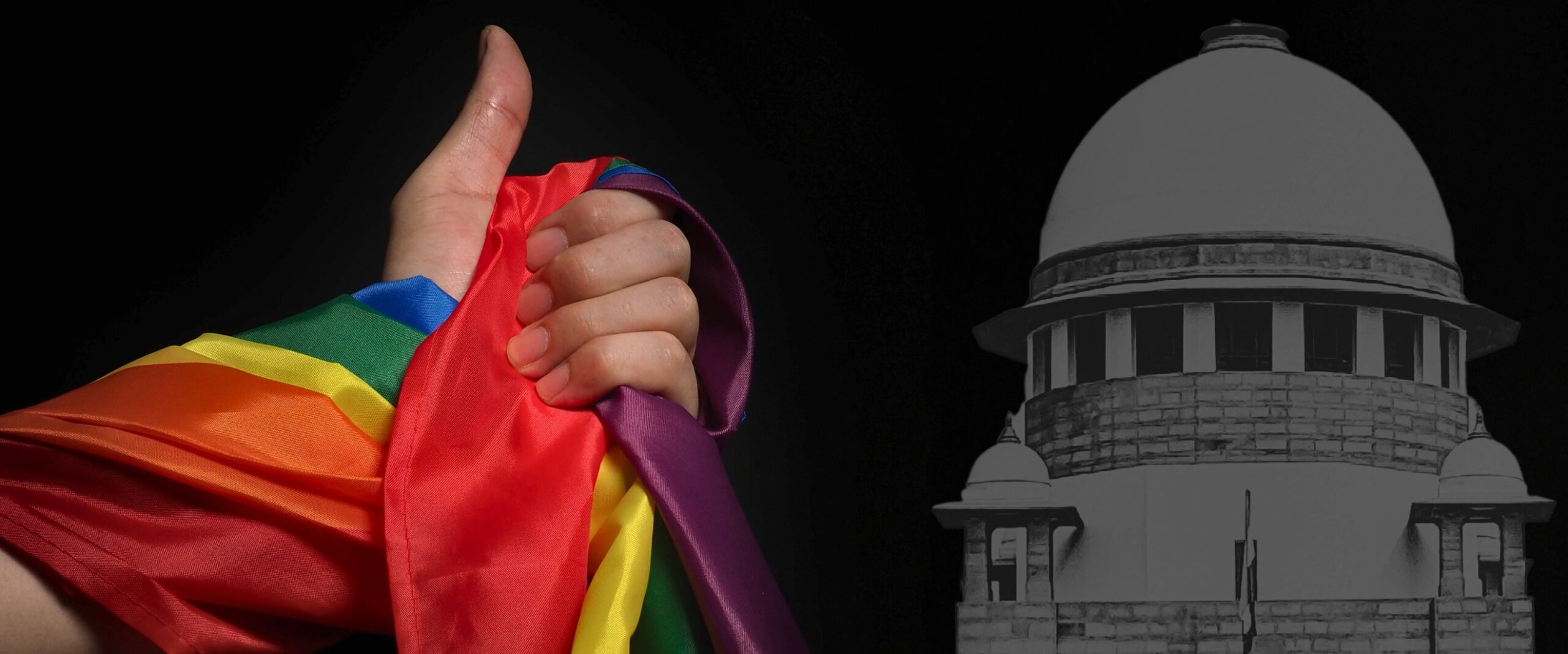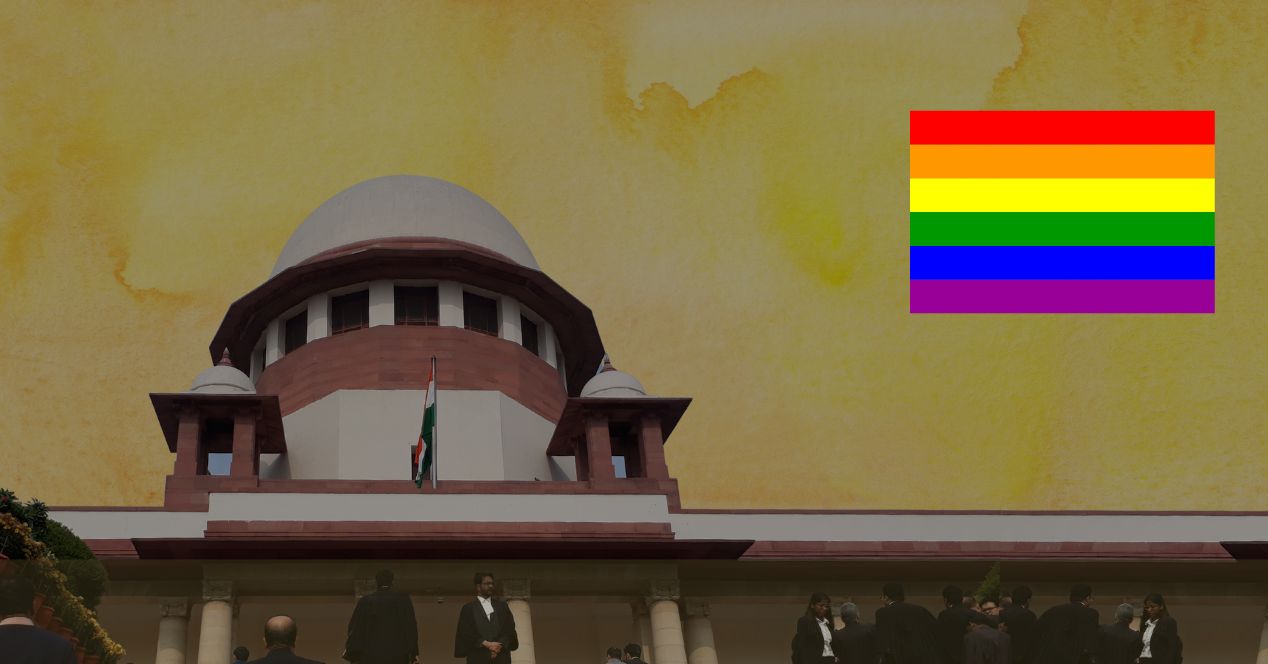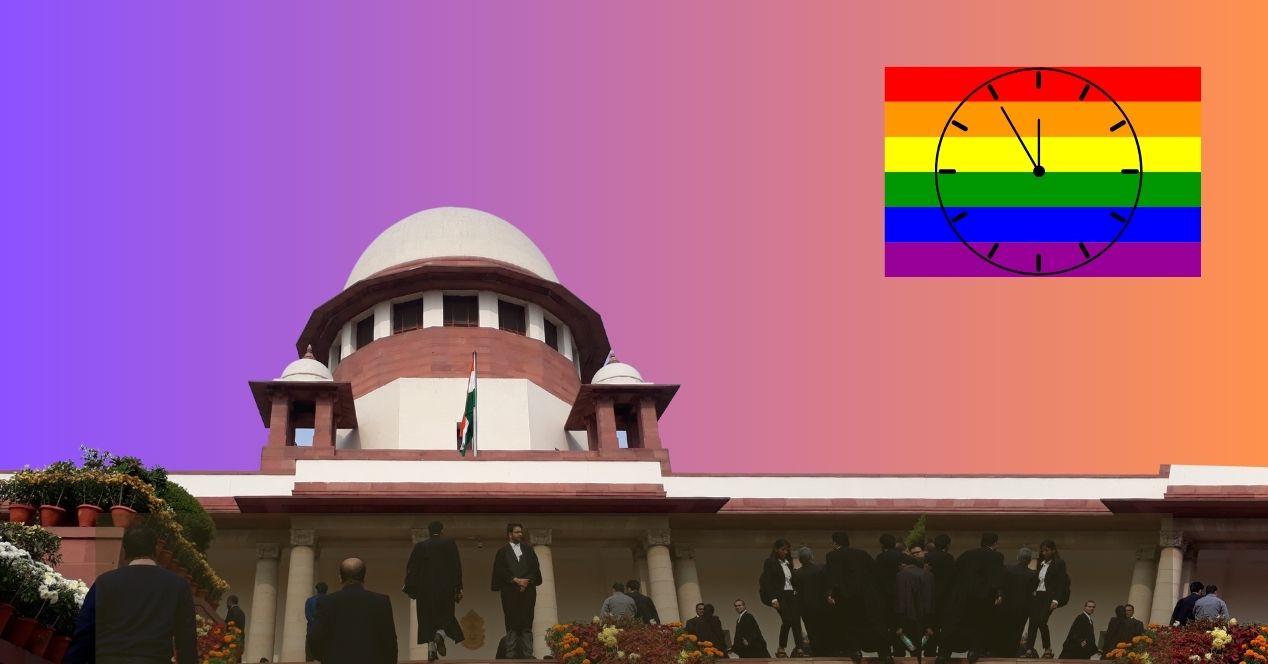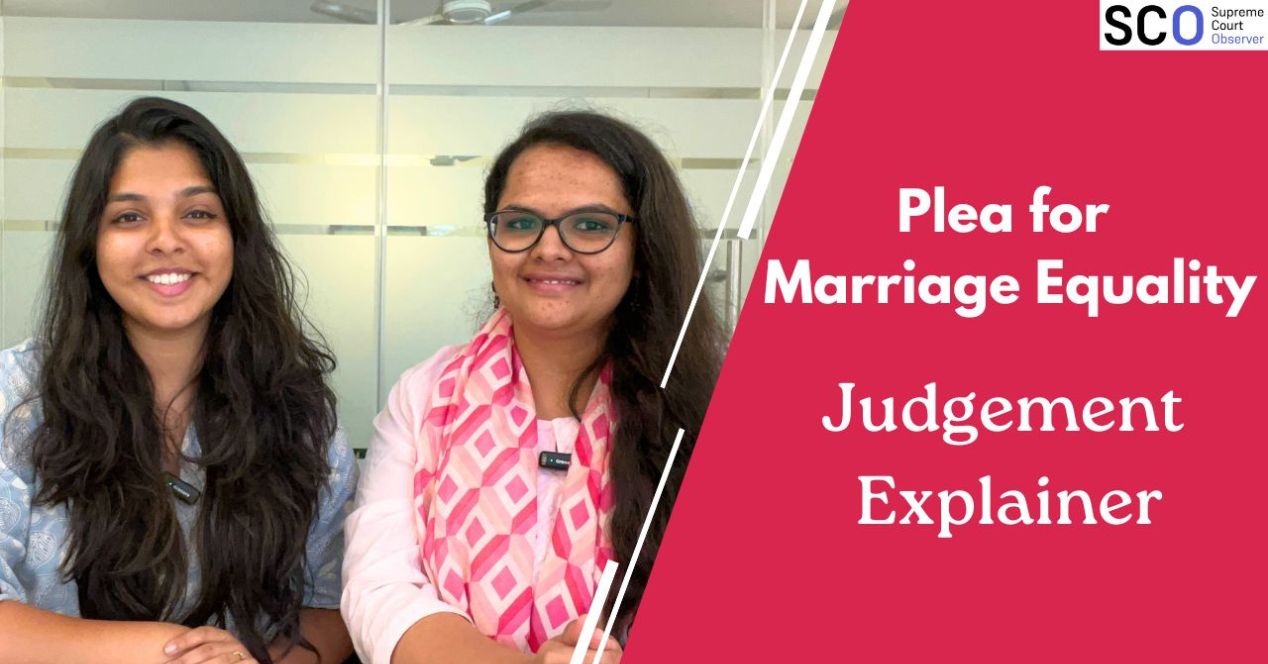Analysis
Marriage Equality: The courts were not the right forum to approach
The marriage rights of sexual minorities involve a polycentric dispute that falls squarely within the legislative domain

On 17 October 2023, a five-judge Bench of the Supreme Court delivered its judgement on marriage equality for sexual minorities in Supriyo v Union of India. The Court held that there is no fundamental right to marry and that the Special Marriage Act, 1954, (SMA) in its current form, is not unconstitutional. Recent news reports suggest that a review petition has been filed against this judgement by Udit Sood, one of the petitioners in Supriyo. In this background, I analyse whether the courts are the right forum to approach for the recognition of marriage equality.
Could the Court have issued the directions under Article 142?
Previously on this website, Diksha Sanyal critiqued Justice S. Ravindra Bhat’s majority opinion while discussing the role of the judiciary as a counter majoritarian institution. She specifically referred to the power of the Court to do “complete justice” under Article 142 of the Constitution. By doing so, Sanyal has rightly expressed doubts about the standard of “all round cooperation” as a prerequisite to issuing Vishaka–type guidelines under the provision. However, in this section, I discuss a different limitation of the Court’s power under the said constitutional provision.
In Supreme Court Bar Association, a five-judge Bench stated that the power to do complete justice under Article 142 does not include the power to disregard or ignore statutory provisions but is only limited to “ironing out the creases” in a cause before it. It held that the Court cannot issue directions that are inconsistent with statutory provisions. It also cited the following extract from A.R. Antulay v R.S. Nayak (1998), which discussed the scope of Article 142:
“…however wide and plenary the language of the article, the directions given by the court should not be inconsistent with, repugnant to or in violation of the specific provisions of any statute.” (emphasis supplied)
If the Court were to issue any meaningful directions that recognised or enforced the right to marry in Supriyo, such interference would have been in direct conflict with, or at the very least inconsistent with, existing statutory provisions. In Supriyo, the petitioners prayed for the gendered words “husband” and “wife” that appear in the (SMA) and allied statutes to be read as “spouse.” Such an exercise, if carried out through the powers vested in the Court under Article 142, would go against multiple Constitution Bench decisions.
Polycentric disputes are within the legislative domain
In Supriyo, the personal laws governing the bouquet of rights arising out of State recognition of marriage were interlocked with many other statutes including criminal codes. It was, therefore, a textbook “polycentric dispute.” While quoting from “The Forms and Limits of Adjudication”—Lon Fuller’s influential Harvard Law Review article from 1978— in its judgement in Indian Ex-Servicemen Movement v Union of India (2022), the Supreme Court had expressed the necessity of judicial deference in adjudicating polycentric disputes:
“We must remember that adjudication cannot serve as a substitute for policy. Lon Fuller described public policy issues that come up in adjudication as “polycentric problems”, that is, they raise questions that have a “multiplicity of variable and interlocking factors, decisions on each one of which presupposes a decision on all others
… Most questions of policy involve complex considerations of not only technical and economic factors but also require balancing competing interests for which democratic reconciliation rather than adjudication is the best remedy. (emphasis supplied)
The best-case scenario: Recognising an “imperfect right”
Could the right to marry have been recognised as an inchoate right or an “imperfect right”? I think it could theoretically, but the very nature of an inchoate right is that it lacks a State-backed remedy, which is what the petitioners were after. In his article for the Bombay Law Reporter in 1972, “The Privy Purse Case: A Criticism”, eminent jurist H.M. Seervai argued that the Court could create an “imperfect right” but this right would be an exception to the general rule of ubi jus ibi remedium (every right has a remedy).
So yes, there is a possibility that the Court could have recognised the right to marry LGBTQIA+ persons as an imperfect “right to marry.” This would be in consonance with Justice Rohinton Nariman’s concurring opinion in Puttaswamy v Union of India, which noted that the right to privacy in India, as in the US, has evolved to recognise “the rights of LGBTQIA+ couples—including the right to marry” within its fold. (This opinion was delivered before the court read down Section 377 of the Indian Penal Code in Navtej Johar v Union of India.)
But the right to marry is grounded in the State’s legal recognition of a union that gives rise to certain benefits and obligations. A right to union plus the formal recognition of the union and its attendant benefits and obligations would result in a truly actionable right to marry. So even if an imperfect “right to marry” was to be recognised, it would only be a semantically glorified right to union between LGBTQIA+ persons which would be no different from what has already been recognised by the Court in Navtej Johar.
The inherent limitations of the methods of statutory interpretation
Since the Bench has dealt extensively with the doctrine of reading down, I restrict my discussion in this section to two other workable methods of statutory interpretation that were suggested by the petitioners: ut res magis quam pereat and the doctrine of updated construction.
The maxim Ut res magis quam pereat suggests that courts should strive to interpret a provision in a way that gives it meaning rather than in a way that renders it void. The petitioners had submitted that the Court should resort to reading the Foreign Marriage Act, 1969 and the SMA to preserve the constitutionality of the statute, similar to how it had proceeded in Githa Hariharan v Reserve Bank of India (1999).
In Githa Hariharan, the issue was whether a mother could be a natural guardian under Section 6(c) of the Hindu Minority and Guardianship Act, 1956 (HMG) during the lifetime of the father if she acted as the guardian of the child with his concurrence. Section 6(a) provided that the mother is a natural guardian of a minor “after” the father. The Court interpreted the word “after” to be understood as “in the absence of” instead of “after the death of the father.” The Court resorted to this reading while respecting the following aspects:
- The interpretation was a natural outcome of the harmonious construction of Sections 4 and 6 of the HMG. The definitions in Section 4 of “guardian” and “natural guardian” did not discriminate against the mother.
- The interpretation adopted by the Court caused no violence to the language of the impugned provision.
In Dhoom Singh v Prakash Chandra Sethi (1975), the Supreme Court held that the following two consequences are to be kept in mind while applying this rule:
- The intention of the legislature may not be treated as vain or left to operate in the air; and
- A statute may not be extended to meet a case for which provisions had undoubtedly not been made.
In Supriyo, the prayer for reading gendered words occurring in the SMA as the gender-neutral word “spouse” is only possible if words are added to the provisions or the ambit of gendered words are read to include categories not covered under the impugned statutes. This directly violates its legislative intent by extending it to the category of ‘non-heterosexual couples.’ Therefore, the Court could not have resorted to Githa Hariharan-style interpretation.
The second method of statutory interpretation suggested was the doctrine of updating construction. The nature of the relief prayed for by the petitioners in Supriyo would have required the updating construction of the gendered words ‘husband’ and ‘wife’ as ‘spouse.’ In the context of the SMA and its allied statutes, the legislative intent was to provide statutory recognition to inter-faith marriages between heterosexual couples and govern such a union on various subjects related to, inter alia, divorce and prohibited degrees of relationships.
A construction of the nature prayed for would have been inconsistent with legislative intent or changed the nature of the legislative enactment. Also, the new state of affairs would be different from the state of affairs in which such construction was employed. These three effects violate the limitations imposed on updating construction in well-established jurisprudence, most notably in Bennion, Bailey and Norbury on Statutory Interpretation, a leading work.
Courts cannot function as an administrative agency
Even if marriage equality were to be recognised through a judicial rewrite of statutes or through the passing of directions, it is important to note the word of caution sounded by the Constitution Bench in Ramachandra Rao v State of Karnataka (2002). Citing Sir William Wade’s “Judicial Activism and Constitutional Democracy in India,” the Court held:
“…it is plain that the judiciary is the least competent to function as a legislative or the administrative agency. For one thing, courts lack the facilities to gather detailed data or to make probing enquiries. Reliance on advocates who appear before them for data is likely to give them partisan or inadequate information. On the other hand, if courts have to rely on their own knowledge or research it is bound to be selective and subjective. Courts also have no means for effectively supervising and implementing the aftermath of their orders, schemes and mandates
…. Courts have also no method to reverse their orders if they are found unworkable or requiring modification.” (emphasis supplied)
The petitioners in Supriyo sought nothing short of a legal miracle which unfortunately finds little grounding in legal precedents or established doctrines. As discussed by lawyer and queer activist Vivek Divan here, no country has had legislative reforms recognising marriage equality within five years of the decriminalisation of queer sex.
The result of this high-profile litigation should nudge the LGBTQIA+ community to regroup and rethink its legal strategy when it comes to marriage equality. Of course, the community is not a monolith and there are bound to be differing views on the judgement and the way forward even within. And if there’s one stark takeaway from the way the Court dealt with petitioners’ arguments, it is that there is a need for more inclusive and extensive community consultations before petitions are filed.
My sense is that a review of the decision in Supriyo may not be the best next step in this fight. There’s enough precedent from the Supreme Court to suggest that a review only lies where there is a glaring omission, patent mistake or grave error that may have crept in due to judicial fallibility. From that perspective, a review petition is likely to fail because the Court has not erred in interpreting the constitutional and statutory framework in Supriyo. The way forward, in fact, may lie in channelising more energy in lobbying with the lawmakers.
Note: The author assisted Mr. Arvind Datar, Senior Advocate, who appeared for the intervenor Dr. Sukama Acharya in the matter.
Jannani is a Chennai-based advocate.




